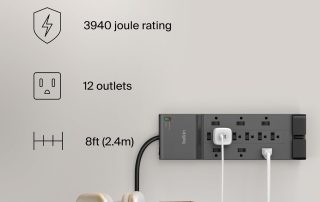As the world becomes more digital, remote work has become increasingly popular. However, working from home comes with its own set of challenges, especially when it comes to cybersecurity. In this blog post, we will discuss how you can make your home office as secure as Fort Knox.
Introduction to Home Office Cybersecurity
Cybersecurity is a critical aspect of any modern-day business or personal life. It involves protecting sensitive information and data from unauthorized access, theft, damage, or loss. When it comes to remote workers, cybersecurity takes on an even greater importance because employees are accessing company resources from their homes, which may not have the same level of security measures in place as the main office. Therefore, it’s essential for both employers and employees to take proactive steps towards ensuring that their home offices are secure.

Common Threats and Vulnerabilities for Remote Workers
Remote workers face several unique threats and vulnerabilities that put them at risk of cyber attacks. Some common risks include:
1. Malware – malicious software designed to gain unauthorized access to systems or steal confidential information.
2. Phishing scams – fraudulent emails or messages sent by attackers posing as legitimate entities to trick users into revealing sensitive information such as login credentials or financial details.
3. Social engineering – tactics used by hackers to manipulate individuals into divulging sensitive information or performing actions they normally wouldn’t do.
4. Unsecured Wi-Fi networks – public Wi-Fi hotspots that lack encryption and authentication mechanisms leave users susceptible to eavesdropping and interception of their communications.
How to Secure Your Home Network and Devices
To ensure maximum protection against these threats, here are some tips on securing your home network and devices:
1. Use strong passwords – create complex passwords that use a combination of letters, numbers, symbols, and uppercase/lowercase characters. Avoid using easily guessable words like “password” or “admin.”
2. Enable two-factor authentication (2FA) – add an extra layer of security by requiring a second form of verification, such as a code generated via SMS or email, before granting access to accounts.
3. Install firewalls – hardware or software-based barriers that monitor incoming and outgoing traffic and block unauthorized connections.
4. Keep operating systems up-to-date – regularly update your computer’s OS and other software applications to patch known vulnerabilities and bugs.
5. Encrypt files and folders – use encryption tools to convert sensitive data into unreadable ciphertext that only authorized parties can decrypt.
6. Disable unnecessary services and ports – turn off features and protocols that aren’t needed to reduce the attack surface area.
Importance of Strong Passwords and Two-Factor Authentication
Strong passwords and two-factor authentication are crucial components of any robust cybersecurity strategy. Weak passwords are easy targets for hackers who use automated tools to crack them open within minutes. Similarly, failing to enable 2FA leaves accounts exposed to brute force attacks where intruders try different combinations until they find one that works. By implementing strong passwords and 2FA, you significantly reduce the chances of falling prey to cyber criminals.
Regular Backups and Data Encryption Best Practices
Backup and data encryption best practices help safeguard against data loss and theft. Here are some recommendations:
1. Regularly backup important data – store copies of vital documents, photos, videos, and other critical files in multiple locations, including external hard drives, cloud storage platforms, and USB flash drives.
2. Use encryption for backed up data – encrypt all stored data to prevent unauthorized access in case of theft or loss of the device holding the backup.
3. Implement full disk encryption – encrypt the entire hard drive of your laptop or desktop PC to shield data from prying eyes if the machine falls into the wrong hands.
Conclusion
In conclusion, making your home office as secure as Fort Knox requires taking proactive steps towards enhancing your cybersecurity posture. From creating strong passwords and enabling two-factor authentication to keeping operating systems updated and backing up data regularly, there are many ways to bolster your defenses against cyber threats. Remember, staying vigilant and informed about potential risks is key to maintaining a safe and secure home office environment.
Are There Any Work From Home Jobs That Are Not Scams
Looking for legitimate work from home jobs? Read this article to find out how to avoid scams and discover genuine remote job opportunities.
Comparing Top Surge Protector Power Strips: Belkin, 18 Outlets, SUPERDANNY
Looking for a reliable power strip surge protector? Compare the top options: Belkin, 18 Outlets, SUPERDANNY. Find the perfect one for your needs.
Comparing CyberPower, APC & QIAN: UPS Systems Reviewed
Looking for reliable backup power solutions? Check out our roundup of CyberPower, APC, and QIAN UPS systems. Find the best fit for your needs!
Comparing 3 LED Desk Lamps: SuperDanny, ACNCTOP, Voncerus
Looking for the perfect LED desk lamp? Check out our roundup comparing the SuperDanny, ACNCTOP, and Voncerus lamps. Find your ideal lighting solution today!
Webcam Review: Logitech C920x vs NexiGo N940P vs 1080P Webcam
Hey there! Looking to upgrade your video conferencing setup? We've got you covered with three fantastic webcam options to help you stay connected with your loved ones, colleagues, and clients. In this...
Printer Showdown: ET-4800 vs ET-2850 vs ET-15000
Looking for a new printer? Check out our Printer Showdown: ET-4800 vs ET-2850 vs ET-15000. Compare features and find the perfect fit on Amazon.







